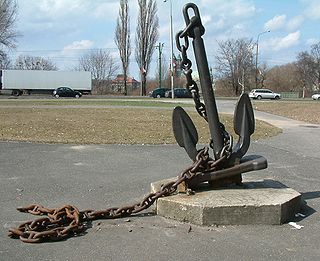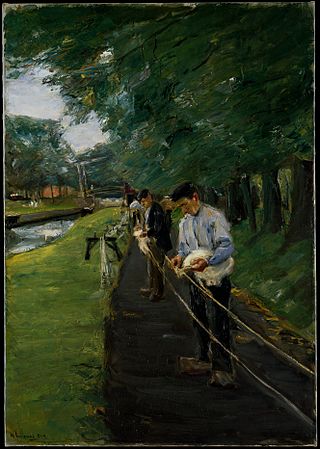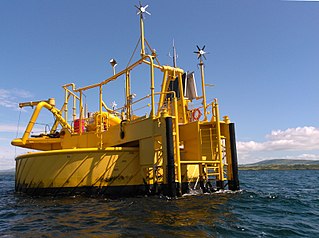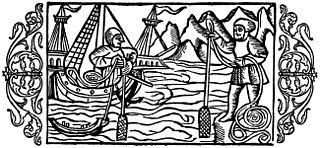
An anchor is a device, normally made of metal, used to secure a vessel to the bed of a body of water to prevent the craft from drifting due to wind or current. The word derives from Latin ancora, which itself comes from the Greek ἄγκυρα.

A fathom is a unit of length in the imperial and the U.S. customary systems equal to 6 feet (1.8288 m), used especially for measuring the depth of water. The fathom is neither an international standard (SI) unit, nor an internationally accepted non-SI unit. Historically it was the maritime measure of depth in the English-speaking world but, apart from within the US, charts now use metres.
A cable length or length of cable is a nautical unit of measure equal to one tenth of a nautical mile or approximately 100 fathoms. Owing to anachronisms and varying techniques of measurement, a cable length can be anywhere from 169 to 220 metres, depending on the standard used. The unit is named after the length of a ship's anchor cable in the Age of Sail.

A mooring is any permanent structure to which a seaborne vessel may be secured. Examples include quays, wharfs, jetties, piers, anchor buoys, and mooring buoys. A ship is secured to a mooring to forestall free movement of the ship on the water. An anchor mooring fixes a vessel's position relative to a point on the bottom of a waterway without connecting the vessel to shore. As a verb, mooring refers to the act of attaching a vessel to a mooring.

A hammock is a sling made of fabric, rope, or netting, suspended between two or more points, used for swinging, sleeping, or resting. It normally consists of one or more cloth panels, or a woven network of twine or thin rope stretched with ropes between two firm anchor points such as trees or posts. Hammocks were developed by native inhabitants of the Americas for sleeping, as well as the English. Later, they were used aboard ships by sailors to enable comfort and maximize available space, by explorers or soldiers travelling in wooded regions and eventually by parents in the early 1920s for containing babies just learning to crawl. Today they are popular around the world for relaxation; they are also used as a lightweight bed on camping trips. The hammock is often seen as a symbol of summer, leisure, relaxation and simple, easy living.

A rope is a group of yarns, plies, fibres, or strands that are twisted or braided together into a larger and stronger form. Ropes have tensile strength and so can be used for dragging and lifting. Rope is thicker and stronger than similarly constructed cord, string, and twine.

A longboat is a type of ship's boat that was in use from circa 1500 or before. Though the Royal Navy replaced longboats with launches from 1780, examples can be found in merchant ships after that date. The longboat was usually the largest boat carried. In the early period of use, a ship's longboat was often so large that it could not be carried on board, and was instead towed. For instance, a survey of 1618 of Royal Navy ship's boats listed a 52 ft 4 in longboat used by the First Rate Prince, a ship whose length of keel was 115 ft. This could lead to the longboat being lost in adverse weather. By the middle of the 17th century it became increasingly more common to carry the longboat on board, though not universally. In 1697 some British ships in chase of a French squadron cut adrift the longboats they were towing in an attempt to increase their speed and engage with the enemy.

Boat building is the design and construction of boats and their systems. This includes at a minimum a hull, with propulsion, mechanical, navigation, safety and other systems as a craft requires.

A tarpaulin or tarp is a large sheet of strong, flexible, water-resistant or waterproof material, often cloth such as canvas or polyester coated with polyurethane, or made of plastics such as polyethylene. Tarpaulins often have reinforced grommets at the corners and along the sides to form attachment points for rope, allowing them to be tied down or suspended.
This glossary of nautical terms is an alphabetical listing of terms and expressions connected with ships, shipping, seamanship and navigation on water. Some remain current, while many date from the 17th to 19th centuries. The word nautical derives from the Latin nauticus, from Greek nautikos, from nautēs: "sailor", from naus: "ship".

Careening is a method of gaining access to the hull of a sailing vessel without the use of a dry dock. It is used for cleaning or repairing the hull. Before ship's hulls were protected from marine growth by fastening copper sheets over the surface of the hull, fouling by this growth would seriously affect the sailing qualities of a ship, causing a large amount of drag.

Wire rope is several strands of metal wire twisted into a helix forming a composite rope, in a pattern known as laid rope. Larger diameter wire rope consists of multiple strands of such laid rope in a pattern known as cable laid.

A ropewalk is a long straight narrow lane, or a covered pathway, where long strands of material are laid before being twisted into rope. Due to the length of some ropewalks, workers may use bicycles to get from one end to the other.

To worm, parcel and serve a line is to apply a multi-layered protection against chafe and deterioration to standing rigging. It is a technique not usually used on modern small boats, but is found extensively on traditionally-rigged sailing ships. Worming, parcelling and serving —referred to collectively as "service"— is traditionally applied only to traditional twisted rope, either natural fiber or steel wire-rope, not the braided line almost exclusively used on modern vessels, but some traditional vessels now use modern high modulus braided lines in place of wire rope and serve the line to maintain the traditional appearance. It can be applied to the entire length of a line, such as a shroud, or selectively, to specific parts of a line, such as over the spliced ends of a stay, where the chafe on the middle section of the stay precludes complete protection.

A Single buoy mooring (SrM) is a loading buoy anchored offshore, that serves as a mooring point and interconnect for tankers loading or offloading gas or liquid products. SPMs are the link between geostatic subsea manifold connections and weathervaning tankers. They are capable of handling any tonnage ship, even very large crude carriers (VLCC) where no alternative facility is available.

Depth sounding, often simply called sounding, is measuring the depth of a body of water. Data taken from soundings are used in bathymetry to make maps of the floor of a body of water, such as the seabed topography.

Xerxes' pontoon bridges were constructed in 480 BC during the second Persian invasion of Greece upon the order of Xerxes I of Persia for the purpose of Xerxes’ army to traverse the Hellespont from Asia into Thrace, then also controlled by Persia.
This glossary of nautical terms is an alphabetical listing of terms and expressions connected with ships, shipping, seamanship and navigation on water. Some remain current, while many date from the 17th to 19th centuries. The word nautical derives from the Latin nauticus, from Greek nautikos, from nautēs: "sailor", from naus: "ship".
Beach gear is equipment and methods that place anchoring on land or in the water to exert pulling forces to salvage a stranded ship.














